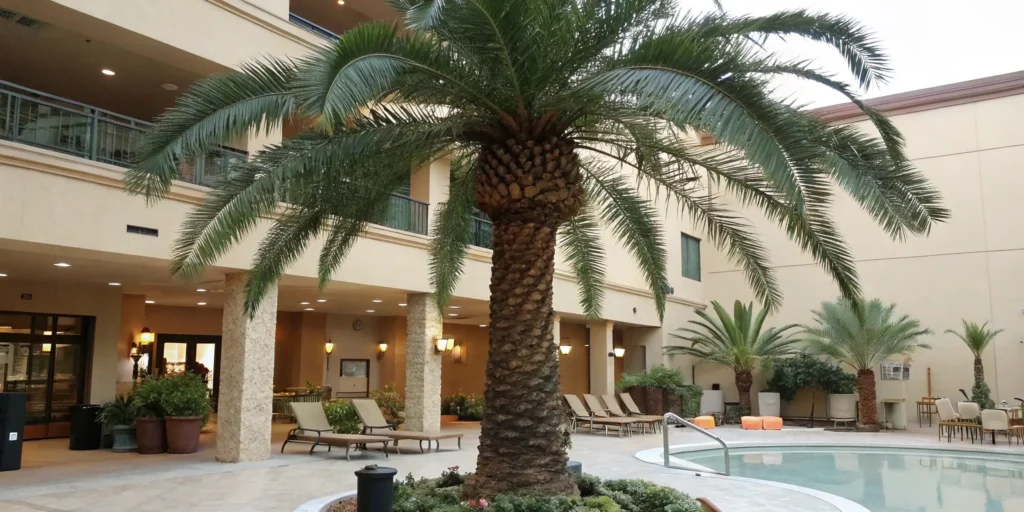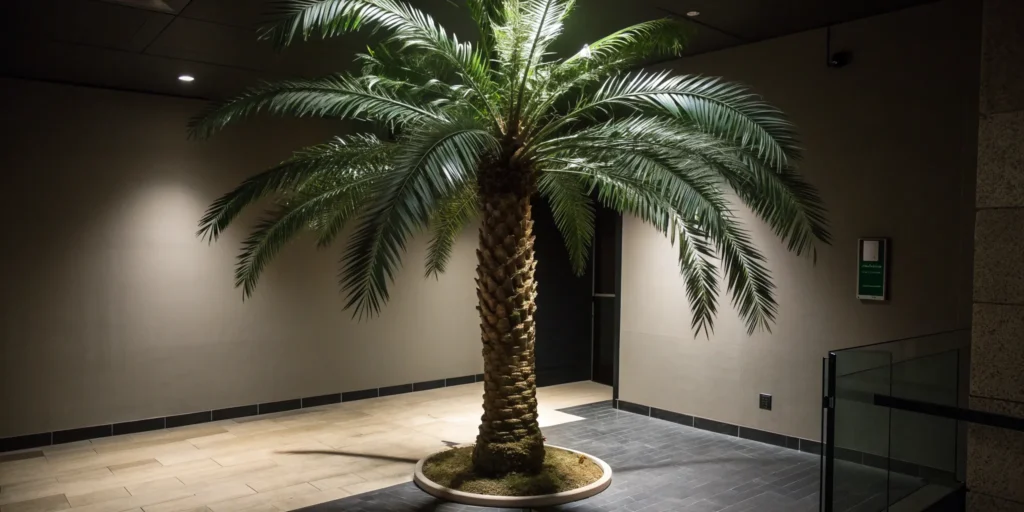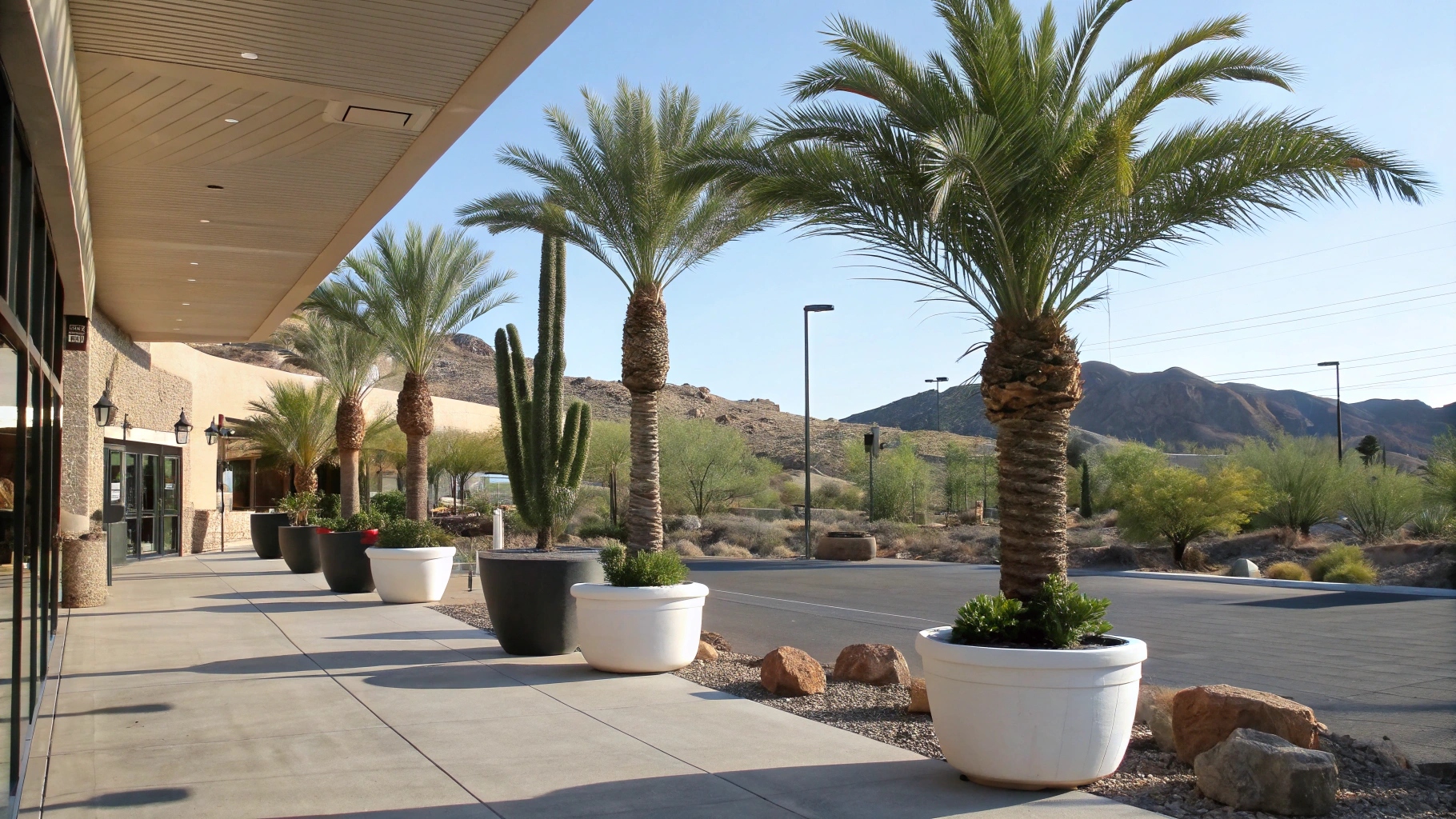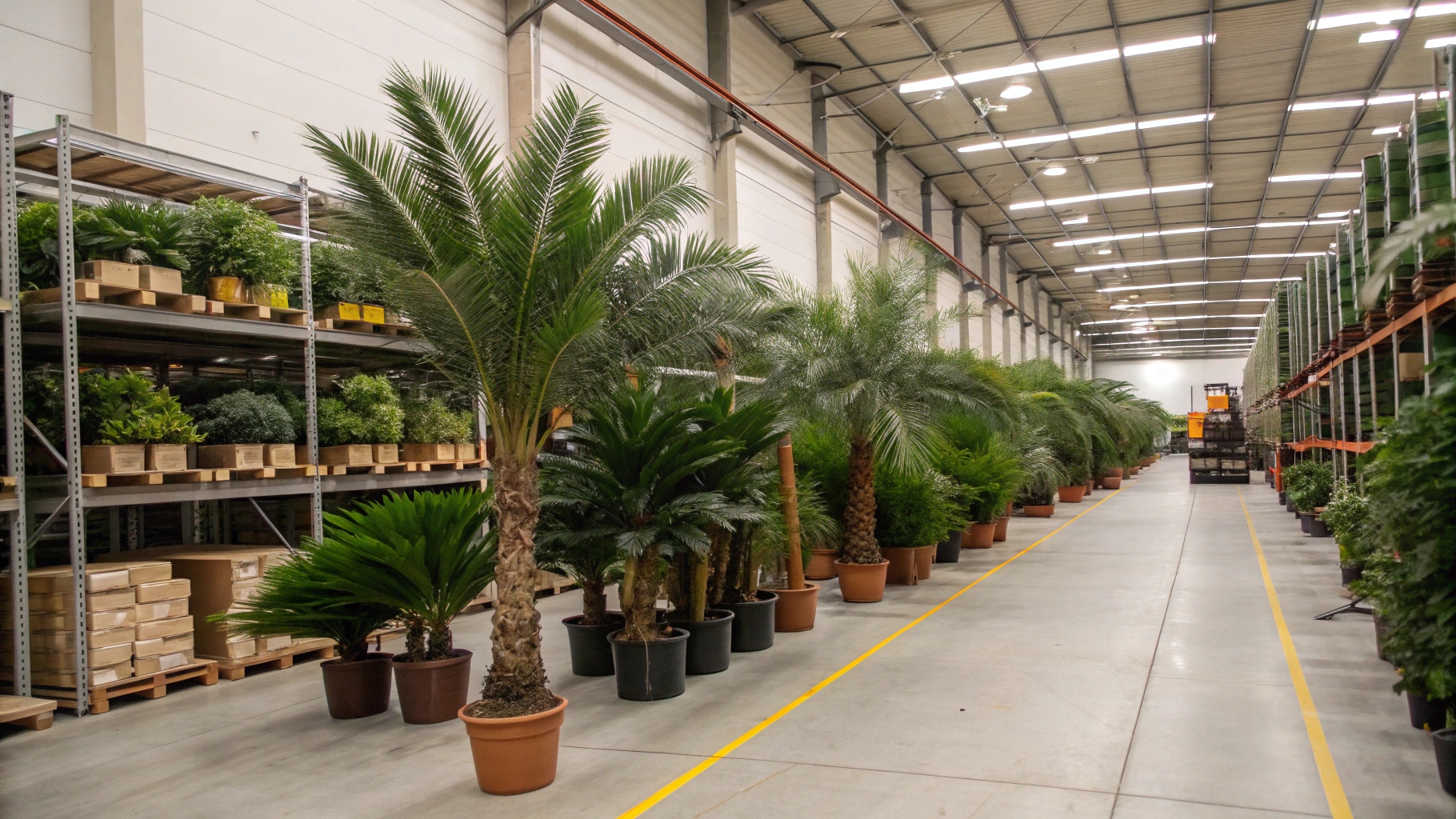Areca Palm, also known as Dypsis lutescens, is one of the most popular tropical plants in the world. It is the gold standard of bringing lush exotic texture, be it to delimit a garden boundary, or to cushion a contemporary interior. However, when introducing such a plant into your room, you have a very important choice to make. Do you prefer the more rewarding complexity of a living tree or the perfect simplicity of a high-quality artificial imitation?
This guide covers all aspects, including initial expenditure and upkeep to adaptability of design and effects to the ecology, which provides you with the understanding required to make the most effective decision to suit your house, landscape, or company.
Last updated: 24th, Oct, 2025 | Estimated reading time: 8 minutes
Meet the Areca Palm Tree
The Areca Palm is not simply a decorative plant, it is a symbol of tropical style. By knowing its natural features, one can understand why its live and artificial versions are so much appreciated.
Natural Habitat and Origin of the Dypsis Lutescens
The Dypsis lutescens, also referred to as the Areca Palm, Yellow Palm or Butterfly Palm, is native to the tropical rainforests of Madagascar. In its natural habitat, it grows in the moist filtered sunlight under the forest canopy. Even when growing it as a houseplant, this origin predetermines its requirement of warm temperatures and humidity. One of the reasons why it has gained popularity all over the world is its ability to tolerate different environments, including bright sunlight and dim interiors, though its warm reception is a major challenge to growers in cooler regions.

Important Characteristics: Fronds, Clustering and Golden Stems
The visual appeal of the Areca Palm is constructed based on three key attributes:
- Arching, feather-like fronds: The leaves are long, curvy, arched with many thin leaflets on them. This makes it soft and feathery and this makes the palm have the Butterfly name since the fronds are curved upwards and outwards like a wing.
- Clustering growth habit: Live Areca Palm unlike the single-stem palms is a clustering plant in that it produces several reed-like stems at its base. This is a thick, multi-stemmed plant that produces a bushy appearance that is optimal in terms of screening and filling space. This is one of the bright-green foliage. It is this golden aspect that makes the plant to be named as the Golden Cane Palm.
Why It Has Become a Landscaping and Design Favorite
The Areca Palm is an essential addition to the landscaping and interior design with its combination of elegant leaves and dense plant growth:
- Architectural softness: It adds a living, tender, natural aspect that harmonizes hard architectural lines, which makes spaces warm and wholesome.
- Privacy screening and hedging: Areca Palm is a thick, clustering plant, thus making it a natural selection in forming fast, efficient privacy screens. The foliage of a property line, or even a pool, is a great visual shield, due to its sheer bulk.
- Indoor air quality: In addition to its beauty, the living palm is hailed for its capacity to filter the usual toxins found in the indoor air, which is an ecological advantage to its beauty.

The Living Palm Tree: Care & Challenges
Purchasing a live Areca Palm is a decision to use a living, natural object which demands constant collaboration and maintenance. There are many advantages associated with the decision to own a live Areca Palm.
- Bright, moving beauty: The foliage changes and evolves, providing a little, vibrant beauty that cannot be duplicated by any lifeless artificial plant. The manner in which the light passes through the natural fronds gives it a distinct atmosphere.
- Air purification: As stated, the palm serves as a natural air filter, which helps to have a healthier home or office environment.
- Gardening satisfaction: To most admirers, the experience of raising a sensitive tropical plant to the full size, deal with its troubles and watch it bloom offers a lot of personal fulfillment.
The Realities: A Detailed Maintenance Schedule
Its tropical character predetermines the rigorous maintenance program that may be complicated, particularly when it is cultivated indoors:
- Watering (Weekly): The plant needs to be watered continuously and regularly to ensure that the soil is not too wet or too dry. Any drying out of the soil even once can result in instant browning of the frond tips, and can be a frustrating occurrence. This usually translates to a weekly schedule that needs accuracy.
- Humidity (daily effort): Indoor air is usually too dry and therefore daily misting or a humidity tray is required to ensure that frond tips do not turn brown. This struggle against dry hot air is enhanced in winter.
- Fertilization (monthly/seasonal): The palm needs monthly feeding with a balanced slow release palm specific fertilizer to ensure that the palm remains of its rich green color and to promote new growth.
- Trimming and pruning (monthly/as needed): There is a need to trim and prune the palm regularly, to stimulate healthy growth and the palm should be kept in a clean shape. This makes the plant appear the best.

Problem-Solving: Yellow Fronds, Brown Tips, and Pests
Troubleshooting a live Areca Palm is an inevitable part of the ownership experience. The following are some of the factors that you have to consider:
- Brown tips: Brown frond tips are the most frequently encountered and usually result either due to lack of humidity, uneven watering or due to salt accumulation in the tap water. The remedies include careful attention, distilled water, and humidity.
- Yellow fronds: Yellowing is typically a sign of either a nutrient deficiency (typically of Magnesium or Iron) or of inappropriate light (excessive exposure to direct, intense sunlight may result in scorching, whereas excessive exposure to light may result in fading). The owners will need to change the fertilization and relocate the plant.
- Pests: Areca Palms, like any other indoor plants, are prone to pests, especially the spider mites, the mealybugs and the scale. Weeding out the pests involves a careful weekly check and treatment with insecticidal soaps or oils, which in most cases turns out to be an endless fight in the house setting.
Advantages of Artificial Palm Trees
Artificial palms have also experienced revolution, as they are no longer viewed as fakes, but very realistic and enduring design solutions, which make life easier in the modern world. In contemporary production technology, artificial foliage has become realistic in a drastic way. Here is how:
- 3D scanning and molds: Manufacturers have adopted the 3D scanning technology to capture the exact texture, veining and fine curves of the live Areca Palm fronds. This information is used to make injection molds and the leaves are made in detail.
- Color gradation and UV coating: Color gradation is used to produce modern leaves to eliminate a one-dimensional, plain shade of green. Artificial foliage of high quality has color gradations that are hand-painted, and resemble natural growth patterns, such as some yellowing at the petiole and darker green ends. Most importantly, the plastic is now frequently filled with UV-resistant materials, which significantly retards the fading and loss of color when placed in the open air or in direct sunlight.
- Trunk and stem detailing: Artificial trunks and stems are made of molded resin or plastic, recreating the roughness and golden color of the natural cane.

Beyond “Fake”: Practical Benefits for Modern Living
The quality change has turned artificial palms into more useful design tools:
- Zero maintenance, zero stress: The first advantage is the most obvious, which is that there is no need to have the complicated watering, fertilization, trimming and pest control routine of live palms. You can acquire all the aesthetic value without spending time.
- Perfect placement: Artificial plants survive where natural ones perish. They may be installed in dark corridors, deep interiors, basements or rooms with excessive temperature changes (e.g., near air vents or doors that are opened and closed frequently) without any problem.
- Lasting cleanliness: Artificial plants are always clean, sterile and unchanging, unlike live plants that lose leaves, attract insects and need soil upkeep.
Demystifying Materials: UV Protection and Eco-Credentials
Knowing the materials will enable you to know when an artificial plant is of a high quality, since the best imitations are not only realistic, but also durable.
- UV protection: The finest artificial palms consist of plastics (such as high-grade polyethylene or polyester) to which UV-resistant agents, referred to as UV inhibitors, have been added. This is essential to the plants growing outdoors, where it will not allow the bright green color to fade away into dull yellows under the bright sunlight. This makes the life of the palm long.
- Eco-credentials: Although live plants are natural, their transportation, fertilization, and water consumption has a cost in terms of the environment. Artificial plants are a single time investment, which removes the usage of water and the use of chemical pesticides. In instances where their life cycle is over, quality artificial foliage can be recycled in most cases, provided the plastics that make up the foliage are separated.

Palm Trees: A Comprehensive Comparison
Here is a side-by-side look at the key differences between the live Areca Palm and its high-quality artificial counterpart across several critical factors.
Cost
Comparing the initial cost with the long-term financial commitment will show the real cost of every palm.
- First cost: The cost of a quality artificial Areca Palm hedge is normally more than that of a similar live one, because it includes the cost of the special materials, craftsmanship and UV protection.
- Total cost of ownership (TCO): The TCO of the live palm is quickly surpassing the price of the artificial version in a few years only.
- Recurring costs (live palm): These expenses are of great importance, such as excessive water consumption, frequent fertilization, frequent pesticide application, repotting supplies, and the time and labor of the owner to take care of it on a regular basis.
- Recurring costs (artificial palm): These costs are insignificant, and they are restricted to dusting or to occasional deep cleaning materials.
- Replacement cost: It is costly to replace the whole live plant, which is required to be replaced because of disease or neglect. Conversely, broken artificial foliage is usually modular and can be repaired at a low cost.
Maintenance
The amount of time one needs to maintain a live palm in good shape is high compared to the little effort needed in maintaining an artificial one.
- Weekly tasks (live): This will need a compulsory weekly work schedule, which is labor-intensive and involves watering, humidity misting and checking on pests.
- Weekly tasks (artificial): This takes very little time, typically just light dusting or rinsing.
- Monthly tasks (live): Requires constant fertilization and pruning of the wilting leaves to keep them in the right shape and in good condition.
- Monthly tasks (artificial): Only optional deep cleaning is necessary in case the palm is put outside.
- Annual work (live): This is heavy work which includes repotting, soil change and deep pruning.
- Annual tasks (artificial): Removes these annual labor tasks completely, which saves the owner a lot of time and effort.
Real Areca Palms require regular care, including watering, pruning, and repotting. Artificial Areca Palms only need periodic cleaning to maintain their appearance. If you want to learn more about care tips on both real and artificial Areca Palms, see our guide: How to Care for Areca Palms: Real vs Artificial Comparison.

Lifespan & Durability
Determine the stability and reliability of your investment in the long term, depending on the environment. For a detailed breakdown, read our full comparison on how long real vs. artificial palms last.
- Live Palm Lifespan: Live palm has the potential of infinite growth, but it is highly delicate. Its life can be easily affected by other factors such as cold drafts, indoor dry air, and neglect, thus it can deteriorate easily.
- Artificial Palm Lifespan (indoor): The lifespan of a high quality artificial palm is predictable and consistent, as it usually has a lifespan of 10-15+ years with easy maintenance.
- Artificial Palm Lifestyle (outdoor): Despite the UV protection, artificial palm outdoors can be strong and still can be observed to fade in appearance after 3-5 years of exposure to direct and intense sunlight, but the structure remains intact.
- Investment type: Investment in the artificial palm is a long-term investment that is predictable and stable.
Design Flexibility
The live palm has extremely rigid environmental demands that severely restrict your capacity to place and style it in various decors.
- Placement restriction (live): The live palm is also limited to locations that are close to natural light, maintain constant temperatures (over 60 F), and areas that are highly humid.
- Placement freedom (artificial): The artificial plant is free and may be installed in any location as design dictates, such as dark interiors, locations close to air vents, or busy locations.
- Shape/size (live): The live palm is always growing and shrinking and it has to be trimmed to keep it in size.
- Shape/size (artificial): The artificial plant is fixed, which ensures that the size and shape of the plant remain exactly as stated in the design brief every year.
- Repositioning: Transplanting a living palm is a dangerous and stressful task, and it needs acclimatization to the new light conditions, whereas transplanting an artificial palm is immediate and safe.

Applications
The best option would be purely based on the reason and location of installation.
- Ideal to live palm: It is best adapted to a specific home setting where the owner has a passion to garden and can offer intensive, daily attention (e.g. bright sunroom), or in tropical areas where it grows well in landscaping.
- Fits perfectly with artificial palm: The best solution in:
- Business areas (hotels, lobby, offices, retail showcases).
- High-traffic areas.
- Poolsides (chlorine fumes immune).
- Where there is low light inside.
- Commercial advantage: The predictable appearance and high hygiene of the artificial palm is a major advantage in business environments.
Environmental Impact
Look at the environmental cost in the long run during the entire life of the palm.
- Water: Live palm has a high and continuous water consumption, which is a considerable environmental cost, particularly in arid areas. The artificial palm does not need any water to maintain.
- Chemicals: Live palm requires frequent application of fertilizer and periodic pesticide application. To clean the artificial palm, only mild soap is needed, which has significantly decreased the amount of chemicals introduced into the home or the environment.
- Disposal: Live palm is natural and biodegradable when disposed. The one-time cost of the artificial palm removes the periodic environmental expenditure on water use and chemicals over its extended life cycle.
Artificial Palm Trees for Every Scenario
High-quality artificial palms are better design solutions in places where live plants simply fail due to their adaptability.
The Sun-Drenched Poolside
Live palms are hard to survive outdoors around pools because of the chlorine fumes and reflected glare of the water, which may be scalding to foliage. The most suitable solution to such sun-drenched places is artificial UV-resistant palms.
- Chlorine resistance: UV resistant plastics are resistant to the corrosive action of chlorine and salt water, which means that the plant will retain its lively color and structure.
- Safety and hygiene: Artificial hedges do not fall in the pool and do not need watering as compared to live plants, which leave the damp soil and standing water that may harbor insects.
- Screening: Artificial Areca palm hedges may be planted immediately to form a complete, thick privacy screen around a pool to ensure complete, full foliage immediately.

The Low-Light Interior
Indoor areas, like offices, lobbies, and interior areas of the deep home, do not receive the 4–6 hours of bright and indirect light that a live Areca Palm requires.
- Constant beauty: Artificial plants do not etiolate (stretch and fade) and die as quickly as natural plants would in dark corners, stairwells and bathrooms.
- High-end environments: In luxury design where looks matter and cannot be compromised, the artificial palm will ensure the required aesthetic appearance is the most preferred even 24/7 without the fear of yellowing or browning leaves.
High-Traffic Spaces
Plants are physically damaged, spilled and subjected to sanitation in lobbies, retail stores and restaurants.
- Durability: Artificial foliage is tough in case of unintended collisions, spills, and dust. The stems are frequently wired or of hard plastic, and cannot be broken off with much more difficulty than the brittle canes of a living palm.
- Cleaning: In commercial applications, cleaning is quick and simple, a quick wipe or hose down is all that is required to clean and keep the standards of hygiene clean without the complex pest control or soil maintenance.

Your Project: Long-Term Care and Installation
Whichever decision you have made, be it live or artificial, you need to plan so that the plant can survive and give you the best out of your investment.
Planting Live Palm Tree Hedge
In zones 10-11, where the Areca Palm tree hedges are used outdoors, the success will be determined by the suitable planting and maintenance:
- Preparation of soil: The soil should be rich, well drained and slightly acidic. To soften the hard clay soil, add sharp sand and fertile compost to it.
- Spacing: The palms should be spacing even to form a hedge that is dense (average spacing is 3 to 5 feet) yet spaced to allow the circulation of air and prevent diseases.
- First growing season: The first growing season is very vital. Water young plants thoroughly and regularly and shield young plants against the scorching afternoon sun until they get established. The control of pests has to start early.
Artificial Palm Trees
Artificial palm tree hedges and trees will provide instant outcomes with low effort:
- Hedging: To create a privacy hedge, multiple artificial palm trees are typically placed side-by-side in a dense line. This method instantly forms a lush, mature-looking tropical barrier, perfect for screening patios, pool areas, or balconies without waiting for plants to grow.
- Potted Trees: In the case of single potted artificial palms, the artificial trees should be placed in a decorative pot where it is anchored using sand, pebbles or expanding foam to make it appear to have a realistic weight and stability.
- Outdoor Security: In case artificial trees are to be placed outside, it is advisable to ensure that the base of the pot is attached to the deck or the ground so that the high winds do not blow the top-heavy foliage.
FAQs about Areca Palms:
1. How do I clean and maintain a high-quality artificial Areca palm to keep it looking fresh?
Maintenance is minimal. In most cases, indoor plants do not require much more than regular dusting with a soft cloth or a feather duster. To wash the deep-rooted plants or outdoor plants, spray the foliage with a garden hose. In the case of hard accumulation, wipe the leaves using a cloth moistened with a weak solution of soap and water. Harsh chemicals or abrasive sponges should not be used, and it may destroy the UV protection coating and accelerate color loss.
2. How realistic do artificial Areca Palms look compared to real ones?
Artificial Areca Palms that are of high quality and modern are incredibly realistic. The finest of these are made of materials and technology that imitates the fine details of the natural palm:
- Texture: Elaborate veining and feathers of the leaves.
- Color: Natural growth-like color shadings (non-uniform color shadings) on its tips (hand-painted) and yellowing on the stems.
- Structure: Stems clustering realistically and the base of the cane having a rough and golden texture.
3. Can artificial Areca Palm hedges be used outdoors?
Yes, they can. However, you have to choose artificial palms that are specially promoted as UV-resistant or UV-rated. The plastic materials used in the manufacturing of these plants have UV inhibitors incorporated in them and this helps the plastic polymers not to degrade and fade away when exposed to the high sunlight. Normal indoor artificial plants will normally fade and become blue in a few months in the outside. The most suitable hedges to use in the long term outdoor landscaping and screening against privacy are UV-rated hedges.

Conclusion
The decision of Areca Palm being natural or an artificial replica of high quality is a compromise between natural dynamism and practicality. Although the live palm can be rewarding in natural growth, it requires a high maintenance schedule, high water consumption and overall cost of ownership is high. It is delicate and it needs a lot of natural light.
However, the contemporary artificial Areca Palm offers lifeless, perfect beauty and zero maintenance and zero recurrent expenditure. It is made of UV-resistant materials and has a realistic appearance that gives it the freedom to be designed in any way, removes the environmental costs, and offers a long life of one long-term investment. In case design, predictability, hygiene and saving time are your top priorities, the artificial Areca Palm will be the most intelligent option for you to experience the tropical flair effortlessly.



